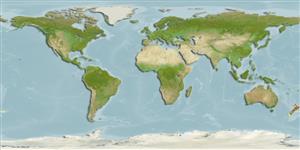>
Aulopiformes (Grinners) >
Aulopidae (Aulopus)
Etymology: Leptaulopus: Name from Greek 'leptos' meaning slender and 'aulopus' for a name long applied to the broader group of fi�shes to which the genusbelong; referring to the slender form of the speciesit comprises; erythrozonatus: Name from Greek 'erythros' for ‘red’ and 'zone' for ‘belt’, referring to the distinctive red bands on the dorsal and caudal fins.
Environment: milieu / Klimaatzone / Diepte / distribution range
Ecologie
marien demersaal; diepte 130 - 280 m (Ref. 94775). Subtropical
Southwestern Pacific: apparently confined to the Australasian region with a trans-Tasman distribution; recorded from New Zealand (Bay of Plenty), northern New South Wales (NE coast of North I. and off Batemans Bay), and yet to be confirmed from Norfolk Ridge.
Grootte / Gewicht / Leeftijd
Maturiteit: Lm ? range ? - ? cm
Max length : 27.4 cm SL mannelijk / geslacht onbekend; (Ref. 94775)
Korte beschrijving
Determinatiesleutels | Morfologie | Morfometrie
Dorsale zachte stralen (totaal) : 15 - 16; Anale zachte stralen: 10 - 11; Wervels: 44. This species is distinguished by the following characters: D 15-16; A 10-11; vertebrae 26 or 27 + 17 or 18 = 44; lateral line scales 44 + 1, below lateral line 4.5; predorsal scales 20; gill rakers 3 + 12; elongated snout, length 11.5-12.4% SL and 34.6-36.5% HL, which is much longer than eye diameter, dorsoventrally flattened, narrowly rounded from above; narrow bony interorbital, width 3.0-3.5% SL and 8.9-10.3% HL; snout tip to dorsal fin origin 42.5-43.7% SL in distance and 128-129% HL; anal �n base 92-9.8% SL and 27.0-29.1% HL; colour of posterior end of maxilla and posterior and ventral margins of preopercle stark white; translucent dorsal fin with 4-6 narrow submarginal stripes from base to outer edge of fin, stripes posteriorly angled obliquely, intervening spaces of fin rays white; caudal fin white with 4-5 red bands crossing each lobe and proximal bands continuous
across fin in some (Ref. 94775).
Body shape (shape guide): elongated; Cross section: oval.
Levenscyclus en paargedrag
Maturiteit | Voortplanting | Paaien | Eieren | Fecunditeit | Larven
Gomon, M.F., C.D. Struthers and A.L. Stewart, 2013. A new genus and two new species of the family Aulopidae (Aulopiformes), commonly referred to as Aulopus Flagfins, Sergeant Bakers or Threadsails, in Australasian waters. Spec. Div. 18:141-161. (Ref. 94775)
Status op de Rode Lijst van het IUCN (Ref. 130435: Version 2025-1)
Gevaar voor de mens
Harmless
Gebruik door de mens
Tools
Speciale rapporten
Download XML
Internetbronnen
Estimates based on models
Preferred temperature (Ref.
123201): 12.3 - 15.2, mean 13.9 °C (based on 12 cells).
Fylogenetische diversiteitsindex (Ref.
82804): PD
50 = 0.7500 [Uniqueness, from 0.5 = low to 2.0 = high].
Bayesian length-weight: a=0.00447 (0.00186 - 0.01072), b=3.12 (2.91 - 3.33), in cm total length, based on LWR estimates for this (Sub)family-body shape (Ref.
93245).
Trofisch niveau (Ref.
69278): 4.0 ±0.7 se; based on size and trophs of closest relatives
Fishing Vulnerability (Ref.
59153): Low vulnerability (23 of 100).
🛈
